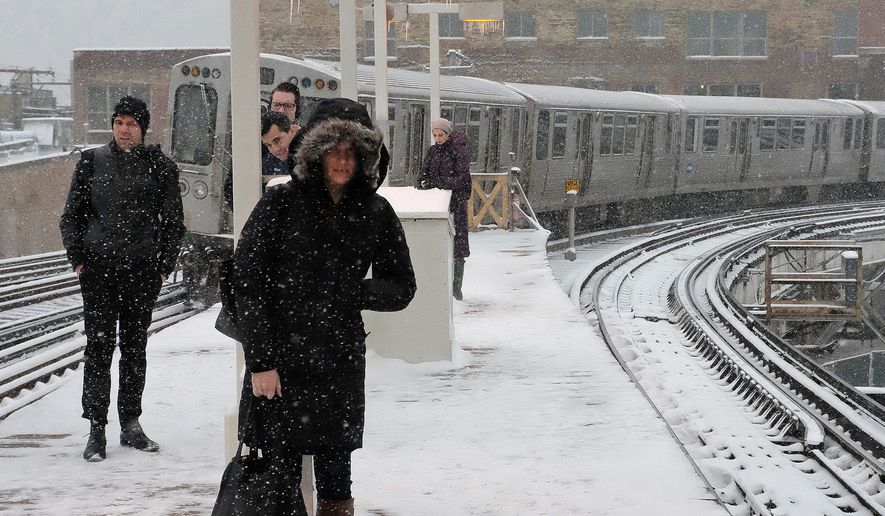The massive East Coast snowstorm comes at an inconvenient moment for the climate change movement.
The looming blizzard puts a chill on the ongoing narrative that this year’s warm winter provides proof of catastrophic human-caused climate change, just as President Trump prepares to sign an executive order this week dismantling the Obama administration’s Clean Power Plan.
It explains why environmental groups such as the Sierra Club prepared for the nor’easter by playing defense, insisting that enormous winter snowstorms are also driven by anthropogenic global warming, just like droughts and warmer temperatures.
“That’s page one of the playbook: All weird weather is caused by global warming,” said Paul “Chip” Knappenberger, a self-described “lukewarmist” who serves as assistant director of the Center for the Study of Science at the free market Cato Institute.
The Sierra Club predicted that Mr. Trump “will laugh about global warming as he signs a repeal of the Clean Power Plan while it’s snowing tomorrow,” then said, “Here’s your prepackaged response when climate skeptics say, ’Lol, it’s snowing so we don’t need climate action’ this week.”
The group pointed to statements by climate scientists Michael E. Mann and Kevin Trenberth, who told ClimateProgress last year that massive snowfalls can be produced by a combination of warmer Atlantic Ocean temperatures and increased water vapor.
SEE ALSO: Nor’easter prompts region to prepare for snow after mild winter
“There is peer-reviewed science that now suggests that climate change will lead to more of these intense, blizzard-producing nor’easters, for precisely the reason we’re seeing this massive storm — unusually warm Atlantic Ocean surface temperatures,” Mr. Mann said in January 2016 before last year’s East Coast blizzard.
Climatologist Roy Spencer, a former NASA scientist and global warming skeptic, had his own prediction Monday: that the “nor’easter and cold temperatures will be blamed on the same climate change that caused unusual warmth over the eastern U.S. over the past couple of months.”
“Global warming theory is in fact so malleable that it predicts anything. More cold, less cold. More snow, less snow,” Mr. Spencer said on his blog. “What a powerful theory. And what’s even more amazing is that climate change can be averted by just increasing your taxes.”
Before this week’s snowstorm, warm winter had come as a boon to the climate change movement, breaking heat records in some areas and producing lower-than-average snowfall in places like Chicago, which had no accumulation in January and February for the first time in 146 years, according to the National Weather Service.
“This is the new climate normal that we all need to come to grips with,” Penn State meteorology professor David Titley told The Associated Press, referring to the balmy February. “And it’s stunning how quickly our climate has changed.”
But it’s also been a “when it rains, it pours” kind of winter. While the East, Midwest and South had warmer-than-average temperatures from December through February, parts of the Pacific Northwest, Northern Rockies and Alaska experienced record cold, according to the National Centers for Environmental Information.
Areas of the West and Great Lakes region broke records for precipitation. After five years of drought, California had its second-wettest December to February on record, with rain and snow at 184 percent of average.
“The U.S. Climate Extremes Index (USCEI) for the winter was 75 percent above average and the seventh highest value on record,” said the NCEI report. “On the national scale, extremes in warm maximum and minimum temperatures, one-day precipitation totals and days with precipitation were much above average.”
The nor’easter is expected to dump as much as 2 feet of snow in some areas, hitting major population centers from Washington and Philadelphia to New York and Boston.
Before anyone can say “this is unprecedented,” however, Mr. Knappenberger pointed out that it’s not.
“An East Coast blizzard in March is rare, but it’s not like it’s never happened before,” Mr. Knappenberger said. “The ’storm of the century’ of 1993 was in mid-March. The Ash Wednesday storm [in 1962] in Virginia. You’ve seen big March storms. This event in and of itself is not unusual, but it’s part of an unusual series of events this winter.”
The Real Climate Science website operated by Tony Heller pointed out that scientists have been all over the map when it comes to climate change, citing predictions dating back to 2000 that snow would be “a thing of the past.”
Last week, UCLA scientists published a study warning that “the [Sierra Nevada] snowpack could largely disappear during droughts,” dropping by 85 percent at the end of the century, thanks to climate change.
“First we were told ’global warming’ means less snow, but then we had record snowfalls in recent winters and they changed the memo to ’global warming’ means more snow. Now we are being told that ’global warming’ is causing more snow and less snow — all at the same time,” said Climate Depot’s Marc Morano. “There is no way to falsify the ’global warming’ claims if every weather event proves the case.”
Figures from the Rutgers University Climate Lab show that this Northern Hemisphere’s winter snow extent is the 10th highest on record.
“Every government climate expert in the world predicted that the snow line would retreat toward the poles due to warmer weather, causing lower extent. The exact opposite is happening,” Mr. Heller said in a Sunday post. “Due to Arctic air incursions penetrating further and further south, snow is falling at lower latitudes and winter snow extent is increasing. This past winter had the 10th-highest snow extent on record.”
As Mr. Morano put it, “This latest snowstorm is a typical late-winter nor’easter. Relax, stay safe and enjoy Mother Nature at her finest.”
• Valerie Richardson can be reached at vrichardson@washingtontimes.com.




Please read our comment policy before commenting.